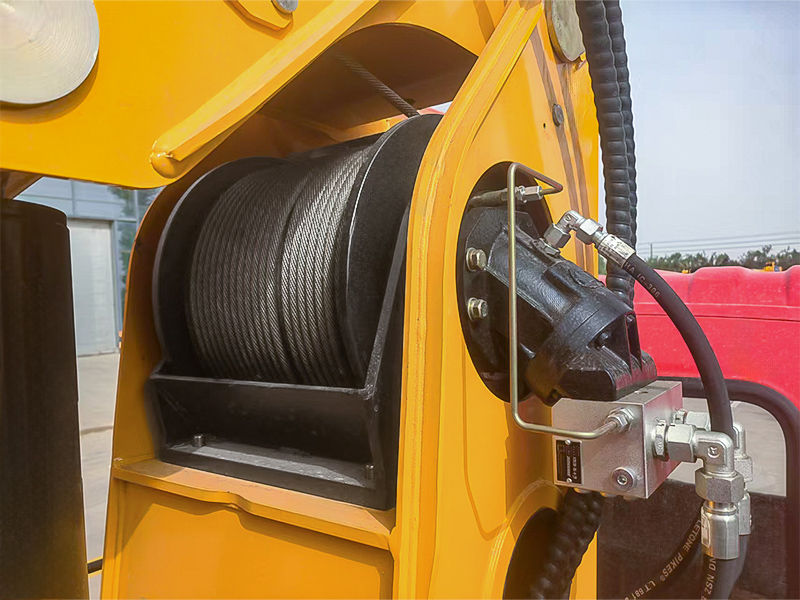
Despite the advancements brought by electric winches, hydraulic winches are still widely used in heavy-duty applications (and for good reasons).
When the job demands consistent power, rugged durability, and long-term reliability under stress, hydraulics still set the standard.
That said, you still cannot just pick any hydraulic winch just because it trumps electric winches in certain areas.
You first need a deep understanding of hydraulic winches to even start considering it. This article has done more than half of that homework for you.
In this guide, you’ll learn how hydraulic winches work, their worth-considering features when picking one, and why they are a good choice for heavy applications like towing, recovery, and construction.
And if you’re looking for industrial-grade winches built for real-world challenges, you’ll also come across ZHIHE’s lineup of hydraulic winches that is worth checking out. Let’s begin.
What Is a Hydraulic Winch?

A hydraulic winch is a mechanical device that pulls or lifts heavy loads using hydraulic pressure.
It has a closed system of fluid mechanics, where pumps, valves, and cylinders work together to produce the necessary force.
The central role in a hydraulic winch is that of the hydraulic pump, which pressurizes a fluid, typically oil or a water-based solution, to deliver consistent and powerful performance under load.
When the system is activated, this fluid is pushed through lines toward the hydraulic motor. The motor responds by performing a rotatary motion, and that rotation is exactly what powers the winch’s drum. As the drum starts spinning, it either winds or unwinds a wire rope (depending on the intended direction of the pull).
To make sure the force generated is usable and controlled, hydraulic winches often come equipped with a planetary gear mechanism. This setup lowers the revolutions per minute (RPM) while increasing torque, the force that’s needed for moving heavy objects.
Most heavy-duty winch setups include the following components:
- A low or high-speed motor
- Closed multi-disc brake
- Support shaft
- Drum
- Planetary gearbox
- An optional clutch
- A distributor (with optional valves)
Hydraulic vs Electric Winches

[Alt text: Image showing a comparison between Zhihe’s hydraulic winch vs electric winch.]
Aside from hydraulic winches, we have electrical winches that perform the same heavy-duty task but using a different technology and technique.
They use electric motors that rely either on direct current (DC) or alternating current (AC) systems. When its electric motor is turned on, it spins the winch drum that, as a result, pulls the load.
Here’s a quick comparison of hydraulic vs electric winches:
| Feature | Electric Winch | Hydraulic Winch |
| Power Source | Electricity (AC/DC) | Pressurized hydraulic fluid |
| Torque Capacity | Moderate, requires larger motor for high torque | High torque even with compact system |
| Installation Cost | Lower | Higher |
| Maintenance Needs | Moderate, mostly electrical checks | High, includes fluid checks, filter replacements |
| Noise Levels | Quiet | Loud and high vibration |
| Environmental Impact | Cleaner, no risk of fluid leaks | Risk of leaks; potential environmental hazard |
| Speed Control | Programmable, with variable frequency drive | Controlled through valves and pressure adjustment |
| Durability in Harsh Environments | Lower resistance to contaminants | High resistance, ideal for extreme conditions |
| Power While Holding Load | Power still required | No power needed once load is held |
| Motor Sensitivity | Sensitive to dust, water, and heat | More robust, handles temperature and debris better |
| Winch Performance Under Load | May slow under high load | Consistent performance even under heavy stress |
Why Choose a Hydraulic Winch for Trucks?
Did you read how hydraulic winches have certain advantages that make them a better fit for specific vehicle applications, especially when it comes to trucks operating in tough environments?
That was just a brief mention. Let’s explore more solid reasons for choosing a hydraulic winch for trucks.

They provide consistent high pulling power for the heaviest jobs
A hydraulic winch for trucks delivers continuous torque strong enough to move several tons without slowing down.
This automatically makes it the go-to winch type for recovery vehicles, heavy-duty construction equipment, and commercial hauling operations that demand uninterrupted pulling capability, even under load.
Hydraulic winches operate better under prolonged use without overheating
Electric winches are all great until the heat starts increasing during extended operation. Hydraulic systems don’t have this problem (at all). They can work for longer durations without performance drops.
They’re built to endure harsh environments with minimal maintenance
Trucks often find themselves in unpredictable conditions like snow, mud, rain, or dust. Hydraulic winches are designed with that in mind. Not having sensitive electrical components allows them to resist moisture, debris, and extreme temperatures.
With minimal maintenance you can keep operating them reliably even after years in rugged terrain.
They’re adaptable to various vehicle sizes and space constraints
Not every truck has a lot of room to spare, particularly medium-duty or specialized vehicles. A hydraulic winch system, especially with an onboard hydraulic pump, can be more space-efficient than a high-torque electric setup that requires oversized motors.
They are better suited for off-grid, remote, or rescue operations
In scenarios where electricity is limited or entirely unavailable, hydraulic systems are your only resort. Trucks already equipped with hydraulic systems (common in utility, recovery, and agricultural vehicles) can integrate a winch without needing an extra power supply.
Hydraulic winches are more sustainable than before
Many modern hydraulic winches now use biodegradable hydraulic fluids that reduce the risk of environmental damage from leaks.
Understanding Winch Power and Performance
Now, let’s understand how a winch’s power is measured and what makes it able to perform efficiently.
How Winch Power Is Measured
Winch power refers to the force a winch can exert to pull a load. You can measure this force in terms of pulling capacity and torque, both of which depend on the mechanical and hydraulic design of the system.
Pulling capacity is generally expressed in tons or kilonewtons (kN), and it varies significantly based on the type of application.
- Light-duty winches are usually rated for 1 to 10 tons
- Medium-duty models for 10 to 50 tons
- Heavy-duty systems can handle up to 200 tons or more
- Extra-heavy-duty winches, often used in industrial or marine environments, may exceed 400 tons
On the other hand, torque is the rotational force generated by the winch motor to turn the drum and move the cable.
In hydraulic winches, torque output is closely linked to the hydraulic pressure applied, the motor’s displacement (i.e., how much fluid it moves per revolution), and the gear ratio if a gearbox is involved.
You can calculate the required torque to achieve a specific line pull by multiplying the pulling force (in kgs) with the drum’s radius (in meters).
- Td (drum torque) = Fmax (line pull) * Rmin (bare drum radius)
For example, if a winch must pull 10,000 kg and the bare drum radius is 0.1 meters, it would need 1,000 daNm (deca Newton meters) of drum torque.
Factors Affecting Performance: Hydraulic Pressure, Flow Rate, Drum Size

Power and torque determine a winch’s baseline capability.
But the actual winch performance in the field depends on the following three more important factors:
Hydraulic Pressure
Hydraulic pressure is the amount of force exerted by the fluid within the hydraulic system. It’s measured using Pascal’s Law, where pressure = force divided by area.
For winching applications, higher hydraulic pressure means greater force output from the motor to the drum. This directly affects how much load the winch can handle.
For example, winches used in industrial or recovery settings may operate at several thousand psi to deliver high pulling capacity. However, pressure must be carefully regulated; while high pressure increases pulling strength, it also places more demand on system components and may require stronger seals, valves, and hoses to maintain efficiency and safety.
Flow Rate
Flow rate determines how quickly the force created by pressure is applied. Technically speaking, this is the volume of hydraulic fluid delivered to the winch motor and is measured in gallons per minute (GPM) or liters per minute (LPM).
A higher flow rate generally results in faster line speeds, which is critical in applications that require quick cable retrieval or rapid deployment. But speed isn’t always the priority. Slower and steadier line movement is often preferred in precision operations such as controlled lowering or retrieval.
Drum Size
The size of the winch drum (its diameter and width included) influences how much rope can be stored and how much torque is required during operation. A larger drum diameter allows for greater rope storage, which is especially useful for applications requiring long cable lengths.
However, a wider or larger drum also increases the effective radius, which in turn demands higher torque to produce the same pulling force. When configuring a winch, you must also follow drum-to-rope diameter ratios to avoid premature rope wear.
Additionally, drum width affects the fleet angle of the rope. If it’s too wide? The rope might not wind evenly, leading to uneven tension or mechanical strain.
Heavy-Duty Winch Features to Consider
In case you’re choosing a hydraulic winch, here are some features that you must consider.
Load Capacity And Safety Ratings
Load capacity is one of the most fundamental considerations when selecting a heavy-duty winch.
If the winch can’t reliably handle the loads you intend to pull, it’s going to be very unsafe.
In most cases, it’s recommended to choose a winch with a capacity rating that’s nearly double the weight of your heaviest expected load.
This extra capacity accounts for several external factors, such as:
- Angle of pull
- Resistance from mud or sand
- Dynamic shock loads
Hydraulic winches, as we discussed earlier, are famous for their ability to handle high-capacity pulling tasks over for long without overheating. That being said, their safe and sound operation still relies on adhering to manufacturer-rated safety limits.
These limits are most often listed as rated line pull, which refers to the maximum pulling force the winch can exert with a single layer of rope wrapped on the drum. As more layers accumulate on the drum, pulling force decreases little bit due to the change in drum diameter.
Build Materials and Corrosion Resistance
| Component | Material Used | Purpose | Durability Features |
| Frame & Housing | High-tensile Steel / Aluminum | Structural support; resists bending under load | Steel provides strength; aluminum reduces weight |
| Gears & Shafts | Hardened Steel or Alloy Steel | Transfers mechanical power to the drum | Withstands high torque and wear |
| Hydraulic Motor | Precision-machined Metals | Converts hydraulic pressure into mechanical movement | Built for longevity and consistent torque |
| Drum | Steel or Aluminum | Spools the winch cable or rope | Steel for heavy-duty use; aluminum in lighter applications |
| Winch Cable/Rope | Steel Wire or Synthetic Fiber | Connects winch to load | Steel offers ruggedness; synthetics provide flexibility |
| Seals & Bearings | Rubber, Ceramic, or Hardened Steel | Keeps hydraulic fluid in; allows smooth drum and motor movement | Designed to handle vibration and pressure changes |
| Control Valves | Stainless Steel or Treated Alloy | Directs and regulates hydraulic fluid flow | Resistant to corrosion and pressure fatigue |
| Protective Coatings | Zinc Plating, Powder Coating, Paint | Shields surfaces from corrosion, rust, and chemical exposure | Extends component lifespan in harsh environments |
| Shock Absorbers | Composite Materials or Rubberized Parts | Dampens sudden jolts during load shifts | Minimizes stress on winch housing and internal components |
Control Options
| Control Component | Type/Option | Functionality | Application Insight |
| Valve Type | Directional Control Valve | Manages direction of fluid flow, determines cable in/out direction | Basic directional control for most hydraulic winches |
| Pressure Control Valve | Regulates hydraulic system pressure to prevent overloads | Critical for system safety and maintaining component longevity | |
| Flow Control Valve | Controls hydraulic fluid flow rate to adjust line speed | Useful in fine-tuning winch speed for different load conditions | |
| Proportional Valve | Allows gradual control of pressure and flow for smoother operation | Common in applications requiring precision (e.g., rescue, lifting) | |
| Servo Valve | Highly responsive valve offering accurate, real-time control | Ideal for sensitive or high-precision pulling operations | |
| Control System | Manual Control | Levers or joysticks for basic in/out operation | Rugged and reliable, especially useful in remote or off-grid areas |
| Electric Control | Buttons or switches, can be PLC-integrated | Suitable for automated or vehicle-integrated winch systems | |
| Remote Control | Wired or wireless remotes for distance operation | Adds flexibility and safety during field operation | |
| Variable Speed Control | Adjusts speed and torque output dynamically | Important for controlled starts, stops, or adapting to terrain | |
| Dynamic Braking System | Uses fluid backpressure to stop the winch smoothly | Prevents shock loading and increases safety during load release |
Mounting and Installation on Trucks
Installation is the phase where many performance and safety issues can either be avoided or unintentionally introduced.
So, let’s now get into how you can easily avoid them without hassle.
Mounting a hydraulic winch for trucks requires alignment, structural integrity, and proper integration into the hydraulic system.
The winch must be mounted to a stable and flat platform, never directly onto the truck’s chassis frame, to prevent misalignment between the motor, drum, and clutch. Misalignment over time can cause premature wear, torque loss, or failure under load.
As a general rule, the same size and number of bolts used to assemble the winch housing and gearbox should also be used to mount the winch. All bolts should be Grade 5 or better and torqued to spec to prevent loosening under vibration or load shifts.
Another important (and non-negotiable) part of installation are hydraulic connections. You must securely attach the hoses with proper fittings and in-line filtration. This is to protect the system from contamination.
Clean hydraulic fluid and functional relief valves are critical for maintaining system pressure without risking a blowout or pressure spike. It’s also essential to double-check fluid levels before the system is powered on.
The control system, whether it’s a simple lever or a full electric interface, should be installed in a location that’s easily accessible to the operator.
Once the entire system is in place, the winch must be tested under no-load conditions to identify any issues with fluid flow, system leaks, or abnormal sounds.
How to Choose the Best Winch for Heavy-Duty Trucks
[Alt text: Image showing a heavy-duty truck using a winch.]
You might think selecting the right winch is only about pulling strength. Far from it. It’s mainly about matching winch power and performance to your exact truck and task.
Here’s a simple way to choose the right one:
- Know your truck’s specs. Check gross vehicle weight and towing demands.
- Match power to purpose. Lighter jobs need less torque. Recovery trucks need high, constant pulling force.
- Look at drum size. Make sure the rope length and diameter suit your job and winching angles.
- Check hydraulic system compatibility (very important). Does your truck already support hydraulics? If not, you need to first plan for that install.
- Compare models and brands. We recommend checking out top models like the Winch Reducer, Rotary Reducer, and Power Head Reducer.
- Balance price and performance. Sometimes paying more upfront saves long-term repair costs.
Also, when selecting a winch for your heavy duty truck, do factor in remote control options, safety ratings, and mounting space.
If you’ve got these basics we just mentioned clear, picking the right winch becomes way easier.
Maintenance Tips for Hydraulic Winches
With fewer fragile parts and strong internal construction, a well-maintained hydraulic winch can easily outlast other systems.
As a matter of fact, there are cases where decades-old hydraulic winches still operate like new.
So don’t take maintenance for granted even if you have the best winch for heavy duty trucks in town.
Let’s show you how to keep your hydraulic winch working like new with routine upkeep.
Good maintenance is typically divided into two key activities: daily inspections and scheduled servicing.
Daily or Frequent Use Checks
These should be performed every day, or after one to two hours of continuous use:
- For hydraulic winches, inspect the entire hydraulic system for leaks. Not to mention, check the fluid level in the reservoir and top it off if needed.
- Examine the winch cable for broken strands, excessive wear, or loss of lubrication. Damaged cable should be addressed immediately.
- Test the automatic worm brake for responsiveness. If its engagement has issues, make the necessary adjustments.
- Ensure the drum clutch engages fully when shifted in. A partially engaged clutch can lead to slippage or uneven winding, which eventually affects performance.
Weekly Maintenance (Every 10 Hours of Operation)
If your winch sees regular use throughout the week, the following steps should be part of your weekly routine:
- Lubricate all bushings equipped with grease nipples using a high-quality lithium-based chassis lube.
- Inspect the winch gearbox oil level and refill if necessary.
- Relubricate the cable based on the specific guidelines provided by your wire rope manufacturer.
Perform the following task every six months:
- Drain and replace the gearbox oil with fresh, clean lubricant as it will help prevent debris buildup and internal wear over time.
FAQs
How much weight can a hydraulic winch pull?
A hydraulic winch can pull anywhere from a few tons up to 400 tons or more, depending on its size, build, and the hydraulic system it’s connected to. The actual pulling capacity will vary based on the winch model and intended application.
Can I install a hydraulic winch on any truck?
No! You can not install a hydraulic winch on every truck out there. Your truck must have a compatible hydraulic system or the space and capability to install one.
What’s better: hydraulic or electric winch?
The choice between hydraulic and electric winches depends on your use case. Hydraulic winches are better for heavy-duty, continuous use and are more durable in extreme conditions. Electric winches are easier to install, quieter, and better suited for lighter, intermittent tasks.
How often should I service my hydraulic winch?
Basic inspections should be done daily or after heavy use. Full servicing, like changing fluids and lubricating components, should be done weekly or monthly depending on usage. A full gearbox oil change is usually recommended every six months.
Is it possible to upgrade my winch’s power?
Yes, you can upgrade winch power by modifying components like the hydraulic motor, increasing system pressure, or adding a different gearbox. However, it’s important to consult the manufacturer or a technician to avoid damaging the system.
Get the Best Winch for Heavy Duty Trucks from ZHIHE
Having read everything, you might now understand that settling for anything less than a purpose-built hydraulic winch simply won’t cut it.
That’s what ZHIHE specializes in.
With over 15 years of hands-on industry expertise, ZHIHE specializes in manufacturing high-performance winches for complex environments and demanding conditions.
Our hydraulic winches deliver the best winch for heavy duty trucks, thanks to being backed by quality engineering, efficient power systems, and reliable support.
Reach out to ZHIHE Intelligent Equipment and let our experts help you find a winch built to work as hard as you do.




